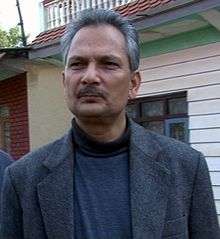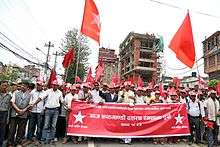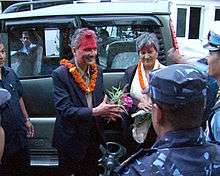Baburam Bhattarai
Baburam Bhattarai (Nepali: बाबुराम भट्टराई, pronounced [ˈbaburam ˈbʱʌʈrai] (born 18 June 1954) is a Nepalese politician and federal Chairman of Janta Samajbadi party who was Prime Minister of Nepal from August 2011 to March 2013. He was a long-time leading member of the Unified Communist Party of Nepal (Maoist) prior to founding a new party, Naya Shakti.
Dr. Baburam Bhattarai | |
|---|---|
डा. बाबुराम भट्टराई | |
.jpg) | |
| 36th Prime Minister of Nepal | |
| In office 29 August 2011 – 14 March 2013 | |
| President | Ram Baran Yadav |
| Deputy | Bijaya Kumar Gachchhadar |
| Preceded by | Jhala Nath Khanal |
| Succeeded by | Khil Raj Regmi |
| Chairman of Naya Shakti Party, Nepal | |
| In office June 2016 – 6 May 2019 | |
| Preceded by | Position established |
| Succeeded by | Office abolished |
| Member of Parliament for Gorkha - 2 | |
| Assumed office 27 May 2008 | |
| Preceded by | Chiranjivi Wagle |
| Personal details | |
| Born | 18 June 1954[1] Khoplang, Gorkha, Nepal |
| Citizenship | Nepalese |
| Nationality | Nepalese |
| Political party | Janata Samajbadi Party, Nepal |
| Other political affiliations | Unified Communist Party of Nepal (Maoist) (before 2015) Naya Shakti (2016-2019) |
| Spouse(s) | |
| Children | 1 |
| Parents |
|
| Alma mater | Tribhuvan University Chandigarh College of Architecture School of Planning and Architecture, Delhi Jawaharlal Nehru University |
| Website | Official Website |
In 1996 the Maoists started the Nepalese Civil War, which had a huge impact on the political system in Nepal. The decade-long civil war, in which more than 12,000 Nepalese died, had a major role in the transformation of Nepal from a monarchy into a republic. Bhattarai was elected to the Constituent Assembly from Gorkha as a Maoist candidate in 2008 and became Minister of Finance in the cabinet formed after the election.
Bhattarai became Prime Minister in 2011. As a way out of the political deadlock since the dissolution of the first Nepalese Constituent Assembly in May 2012, he was replaced by Chief Justice Khil Raj Regmi as head of an interim government that was to hold elections by 21 June 2013.[2] He was a senior Standing Committee member and vice chairperson of the Maoist party until his resignation from his post and all party responsibilities on 26 September 2015. He was until recently the Coordinator of the Naya Shakti. As of 2019, he is the Chairman of the Federal Council of the newly formed Samajbadi Party, Nepal, a party formed by the merger of the Naya Shakti Party, Nepal and the Federal Socialist Forum, Nepal.
Maoist insurrection
On 4 February 1996, Bhattarai gave the government, led by Nepali Congress Prime Minister Sher Bahadur Deuba, a list of 40 demands, threatening civil war if they were not met. The demands related to "nationalism, democracy, and livelihood" and included such line items as the "domination of foreign capital in Nepali industries, business and finance should be stopped", and "discriminatory treaties, including the 1950 Nepal-India Treaty, should be abrogated" (referring here to the 1950 Indo-Nepal Treaty of Peace and Friendship), and "land under the control of the feudal system should be confiscated and distributed to the landless and the homeless."[3] They started armed movement before the deadline to fulfill the demand given by themselves to the government. After that, and until 26 April 2006, the guerrilla leader Prachanda directed the military efforts of the CPN (M) towards establishing areas of control, particularly in the mountainous regions and western Nepal.
The 40 demands were whittled down to 24 in subsequent political negotiations.[4]

In late 2004 or early 2005, the relations between Prachanda and Bhattarai cooled down.[5] This was reportedly due to disagreement on power sharing inside the party. Bhattarai was unhappy with the consolidation of power under Prachanda. At one point, Prachanda expelled Bhattarai from the party, though he was later reinstated.[6] They later reconciled at least some of their differences.[7][8]

On 22 November 2005, Prachanda and the Seven Party Alliance released a "twelve-point agreement" that expressed areas of agreement between the CPN(M) and the parties that won a large majority in the last parliamentary election in 1999. Among other points, this document stated that a dictatorial monarchy of King Gyanendra is the chief impediment to progress in Nepal. It claimed further that the Maoists are committed to human rights and press freedoms and a multi-party system of government. It pledged self-criticism and the intention of the Maoists and the Seven Parties to not repeat past mistakes.[9]
Ceasefires
Several ceasefires have occurred over the course of the Nepalese civil war.[10] Most recently, on 26 April 2006, Prachanda announced a ceasefire with a stated duration of 90 days. The move followed weeks of massive protests—the April 2006 Nepalese general strike— in Kathmandu and elsewhere that had forced King Gyanendra to give up the personal dictatorship he had established on 1 February 2005 and restore the parliament that was dissolved in May 2002.
After that, a new government was established by the Seven-Party Alliance. The Parliament and the new government supported the ceasefire and started negotiations with the Maoists on the basis of the twelve-point agreement. The two sides agreed that a new constituent assembly will be elected to write a new constitution, and decide the fate of the monarchy. The Maoists want this process to end with Nepal becoming a republic of Nepal.[11]
Naya Shakti
On 12 July 2016, Baburam Bhattarai announced the establishment of the Naya Shakti Nepal (New Force Nepal) as a new political party under his leadership.[12] On 24 January, he had announced to establish a new political force. The leaders of Major Parties attended the ceremony. Ashok Sharma, Karishma Manandhar and other 33 new members were announced in that ceremony. He took part in a ceremony announcing an alliance with CPN UML and CPN Maoist centre but left the alliance after two weeks as he was not guaranteed an election ticket.[13]. karishma Manandhar is no more affiliated with this party now. She is giving emphasis on completion of her higher studies. https://nepalijob.com/congratulations-karishma-karishma-manandhar-passed-see-examination/

Personal life
Bhattarai was born in Gorkha Belbas in Khoplang VDC. He was born in a low-middle class peasant family. He has three siblings: one elder sister, one younger sister and one younger brother. He belongs to Brahmin group.[14]
He completed his secondary school education from Amar Jyoti High School in Luintel, Gorkha. He was a classmate of Upendra Devkota.[15] He went to high school at Amrit Science College.[16] After that under the Colombo plan scholarship, he studied Bachelor of Architecture in 1977 from Chandigarh.[17] "He had been an outstanding student," says Lieut-Col Bakshi (retd), Principal of the college.[18] It was during this time he became the founding President of All India Nepalese Student's Association. This organization ended up becoming his first step towards building his academic interests outside the field of architecture.
Bhattarai went to the Delhi School of Planning and Architecture for an M.Tech degree. He is married to Hisila Yami, a fellow Maoist leader. They have a daughter, Manushi.

He completed his PhD degree from Jawaharlal Nehru University (New Delhi) in 1986.[19] His Ph.D. thesis was later published as a book "The Nature of Underdevelopment and Regional Structure of Nepal- A Marxist Analysis".
Publications
Bhattarai has contributed a number of published works, including The Nature of Underdevelopment and Regional Structure of Nepal: A Marxist Analysis (Adroit Publishers, Delhi, 2003) which is a cursory rewriting of his PhD thesis. Other works include Politico-Economic Rationale of People's War in Nepal (Utprerak Publications, Kathmandu, 1998), and Nepal! krantika aadharharu (in Nepali) (Janadisha Publications, 2004). His books and articles have had some impact on Nepalis both at home and abroad, though primarily only on those who share his political beliefs. Among his many well read newspaper articles is "Let’s Give No Legitimacy to the Beneficiaries of the New Kot Massacre"[20] written in the aftermath of Palace Massacre of 2001. Similarly, it is widely believed that he is the principal author of the most successful Election Manifesto brought out by Communist Party of Nepal (Maoists) in March 2008 in preparation of the Constituent Assembly Election held in April 2008.[21]
References
- "शब्दचित्रमा बाबुराम भट्टराई". www.baburambhattarai.com. Archived from the original on 22 November 2010.
- "Nepal's Chief Justice takes the oath". Deccanherald.com. 14 March 2013. Retrieved 20 November 2014.
- Baburam Bhattarai, "40 Point Demand", South Asia Intelligence Review, 4 February 1996
- "Maoists Demand Interim Constitution," Archived 27 September 2008 at the Wayback Machine Kathmandu Post, 28 April 2003
- Singh Khadka, "Nepal's Maoist leadership divisions," BBC, 6 May 2005
- "Official expelled from Maoist party". Archived from the original on 13 June 2011. Retrieved 4 November 2011.CS1 maint: BOT: original-url status unknown (link). tvnz.co.nz. (15 March 2005).
- Charles Haviland, "Meeting Nepal's Maoist leader", BBC, 16 June 2005
- Sanjay Upadhya, "Nepal: Maoists hide More Than They Reveal", Scoop (16 February 2006).
- Unofficial translation, "The 12-point agreement between the Maoists and the seven-party alliance as listed in the statement by Pushpa Kamal Dahal on Tuesday," Archived 29 August 2008 at the Wayback Machine Nepal News (25 November 2005).
- Kamala Sarup (ed.), "Maoists declare three-month-long ceasefire," Archived 17 July 2011 at the Wayback Machine Peace Journalism/Nepal News, (3 September 2005).
- "Nepal Maoist rebels declare truce," BBC (27 April 2006).
- "Baburam Bhattarai announces establishment of Naya Shakti Nepal". The Himalayan Times. 12 June 2016. Retrieved 17 June 2016.
- "Early setback for left alliance as Bhattarai decides to quit". Retrieved 25 October 2017.
- "We did the right thing by leaving Prachanda-Hisila Yami". The Wire. Retrieved 13 December 2017.
- "#11 - Kulendra Devkota, 83 years old, educator and agriculture enthusiast [Nepali]". Aji's. Retrieved 20 April 2020.
- "Always first Baburam Bhattarai, first in politics too". ekantipur. 29 August 2011. Archived from the original on 21 January 2014. Retrieved 29 August 2011.
- "Nepal's Geography of Underdevelopment". Richard Peet.
- The Tribune, Chandigarh, India -Main News. Tribuneindia.com (10 June 2001). Retrieved on 3 June 2012.
- Shrishti R L Rana"Bhattarai at JNU- a vignette". Archived from the original on 22 April 2008. Retrieved 16 April 2008.CS1 maint: BOT: original-url status unknown (link) . kantipuronline.com (29 March 2006)
- Monthly Review June 2001 | Commentary. Monthlyreview.org (17 May 2012). Retrieved on 3 June 2012.
- "CFFN – Historic Documents – CA Manifestos – CPNM(Maoists) – 2008 March". Archived from the original on 27 July 2010. Retrieved 8 May 2008.CS1 maint: BOT: original-url status unknown (link). cffn.ca
External links
| Wikimedia Commons has media related to Baburam Bhattarai. |
| Political offices | ||
|---|---|---|
| Preceded by Jhala Nath Khanal |
Prime Minister of Nepal 2011–2013 |
Succeeded by Khil Raj Regmi |
